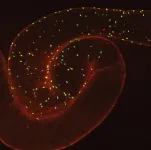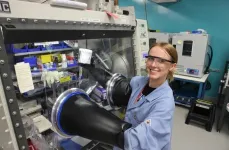(Press-News.org) PROVIDENCE, R.I. [Brown University] — Biologists at Brown University have discovered how a neuropeptide hormone made in the gut of flies can control their lifespan.
The findings, published in PNAS, have implications for humans, too, the researchers say — especially as new diabetes and obesity medications based on gut hormones in the same family of the fly hormone are becoming more widespread.
For the past two decades, study author Marc Tatar, a professor of biology affiliated with the Center on the Biology of Aging at Brown University, has studied how the hormones insulin and insulin-like growth factors (IGFs) control aging in flies.
“We know that reducing insulin, and reducing IGF signaling, slows aging and extends lifespan in flies,” Tatar said.
Tatar approaches the study of aging from the perspective of ecology and evolutionary biology, one part of the interdisciplinary approach taken by the Center on the Biology of Aging. Researchers in Tatar’s lab have been looking at an insulin-regulatory hormone in flies called neuropeptide F (NPF) that is produced in the gut and secreted into circulation in response to diet.
For the PNAS study, they found a way to use genetic tools to reduce the ability of fly intestines to secrete NPF and therefore reduce insulin secretion. Then they mapped the production of NPF in the flies from the gut to the brain to a pituitary-like tissue, and connected this all back to diet.
They found that suppression of gut NPF extends longevity in flies, as does blocking the NPF receptors in the brain that control another hormone called juvenile hormone. The researchers concluded that gut NPF modulates aging of flies through the integration of nutrient sensing, insulin signaling and juvenile hormone production.
“We showed how all of these things work together to control lifespan,” Tatar said.
The researchers are conducting additional experiments to understand what happens when they increase NPF secretion, and therefore increase insulin, in flies.
“Based on this research reported in PNAS, we suspect that over-production of gut NPF in flies will have a negative effect on aging and decrease lifespan,” Tatar said.
As small and simple as flies may seem, Tatar said they actually have many of the same genes as humans, and there are analogous hormones in humans that are involved in similar processes and pathways. Understanding aging mechanisms in flies may help explain what’s happening in humans, as well.
Humans don’t make NPF or juvenile hormone. However, humans do make insulin, and they secrete gut hormones that regulate the production of insulin, such as pancreatic polypeptide Y (PPY) and glucagon-like peptide-1 (GLP-1). GLP-1 is in the same family of hormones as NPF — they’re both called incretins because they can increase the secretion of insulin.
There has been an explosion of research on GLP-1 agonists, which mimic the incretin GLP-1 in humans and trigger the release of insulin in the pancreas.
Tatar’s research team concluded that given how insulin-increasing drugs like GLP-1 agonists are used to treat diabetes and obesity, and given what they’ve found about the relationship between insulin and aging in files, it may be time to consider how they could impact human aging.
“The fly is an excellent model for humans, but we need to progress the research from flies to mice and set up studies that look at GLP1-agonists and aging,” Tatar said. “It will take years, but it’s important.”
The research was funded by the National Institutes of Health (R01AG059563, R37 AG024360, R21AI167849) and the Czech Science Foundation.
END
Brown researchers show how gut hormones control aging in flies and how it relates to human biology
The discovery of a gut-to-brain regulation pathway in flies calls for additional consideration on how certain medications can be used to treat obesity and diabetes in humans.
2024-10-16
ELSE PRESS RELEASES FROM THIS DATE:
Which clot-busting drug is tied to better recovery after stroke?
2024-10-16
EMBARGOED FOR RELEASE UNTIL 4 P.M. ET, WEDNESDAY, OCTOBER 16, 2024
MINNEAPOLIS – For people with ischemic stroke, treatment with the clot-busting drug tenecteplase is associated with a slightly higher likelihood of an excellent recovery and reduced disability three months later than the drug alteplase, according to a meta-analysis published in the October 16, 2024, online issue of Neurology®, the medical journal of the American Academy of Neurology. Researchers found that the likelihood of good recovery was similar ...
Study: breast cancer drug shows potential for rare appendix cancer
2024-10-16
Researchers at University of California San Diego School of Medicine found an FDA-approved drug used to treat breast cancer has the potential to be an effective therapeutic for a specific type of appendix cancer.
The clinical trial results, publishing in the October 16, 2024 online edition of the Journal of Clinical Oncology, showed the oral medication, known as palbociclib, stabilized tumor growth and reduced blood tumor marker levels in patients with peritoneal mucinous carcinomatosis (PMC). This form of cancer originates in the appendix and is often resistant to standard chemotherapy.
“Finding that a breast cancer drug is ...
Specific type of DNA could be a target of future cancer therapies
2024-10-16
Research published in Nature Genetics on Oct.14, by Yale Cancer Center researchers at Yale School of Medicine, found a higher concentration of a specific kind of DNA — extrachromosomal or ecDNA — in more aggressive and advanced cancers that could mark them as targets for future therapies.
Using data available from The Cancer Genome Atlas, the International Cancer Genomics Consortium, the Hartwig Medical Foundation, and the Glioma Longitudinal Analysis Consortium, the researchers considered more than 8,000 tumor samples, divided between newly diagnosed untreated tumors and those that had been through previous treatments ...
New Director of the Bates Center for the Study of the History of Nursing
2024-10-16
PHILADELPHIA (October 16, 2024) – J. Margo Brooks Carthon, PhD, RN, FAAN, the Tyson Family Endowed Term Chair for Gerontological Research; Professor of Nursing in the Department of Family and Community Health; and Associate Director of the Center for Health Outcomes and Policy Research, has been appointed the new Director of the Barbara Bates Center for the Study of the History of Nursing (Bates Center), the preeminent history of nursing research center and archive. The Bates Center amplifies the importance of the history of nursing and healthcare to the development of crafting effective health policies and strategies to improve health for all.
“The ...
Scientists developing microchips with brain and lung tissue to study viral neuroinflammation
2024-10-16
Scientists are developing advanced tools to understand and treat neurological symptoms such as brain fog associated with respiratory diseases like influenza. The Biomedical Advanced Research and Development Authority (BARDA), part of the Administration for Strategic Preparedness and Response (ASPR) within the US Department of Health and Human Services (HHS), awarded a three-year contract to researchers at the University of Rochester to develop a technology to model respiratory disease effects on the brain ...
Discover science: Applications open for summer 2025 undergraduate internships
2024-10-16
WASHINGTON, DC – As the nation continues to build a diverse, clean-energy workforce, the Department of Energy (DOE) today announced that applications are being accepted for the Summer 2025 term of two undergraduate internship programs.
The Office of Science Undergraduate Laboratory Internships (SULI) program and the Community College Internships (CCI) program are unique opportunities open to all current and recent college undergraduates. Interns will learn about science and technology careers, team science, networking, and gain the experience needed to transition from internship to employment.
The application deadline for both programs is January 8, 2025, ...
Can electricity treat high blood pressure?
2024-10-16
UNIVERSITY PARK, Pa. — Several medications are available to treat high blood pressure, but more than 10 million Americans do not respond to the treatments, according to the American Heart Association. Using a bioelectronic device to deliver pulsed electricity to the body has proven to be a promising strategy to treat drug-resistant hypertension patients, according to Penn State researcher Tao Zhou, although he noted that its practical application in patient care has significant limitations.
Zhou, assistant professor of engineering science and mechanics and of biomedical engineering, received ...
Microplastics detected in dolphin breath
2024-10-16
U.S. researchers have detected microplastic particles in air exhaled by wild bottlenose dolphins, suggesting that inhalation may be a relevant route of exposure to these potentially harmful contaminants. Miranda Dziobak of the College of Charleston in South Carolina, U.S., and colleagues present these findings in the open-access journal PLOS ONE on October 16, 2024.
Around the world, humans and numerous other animals are exposed to tiny particles of plastic contaminants known as microplastics. In humans and rodents, microplastic exposure has been linked to adverse health impacts, such as oxidative stress and inflammation. Ingestion ...
Global north’s growing appetite for farmed salmon imperils communities’ access to local fish
2024-10-16
A new paper published today in Science Advances exposes the global aquaculture sector’s growing dependence on wild fish. Despite industry claims to the contrary, these findings highlight how the growing appetite for expensive farmed salmon can leave coastal communities struggling to access affordable local fish like sardines and anchovies. Instead, these small pelagic fish are frequently caught, processed, and “reduced” to fishmeal and fish oil, almost all of which is used to feed farmed fish. These ‘reduction fisheries’ account for 26% of global ocean catch.
“As the aquaculture industry grows, so does its ...
e-Flower records neuronal activity with electronic petals
2024-10-16
Neural spheroids — 3D clusters of brain cells — are emerging as essential tools for understanding neural networks and studying neurological diseases in the lab. EPFL’s e-Flower, a flower-shaped 3D microelectrode array (MEA), allows researchers to monitor the electrical activity of these spheroids in a way that was previously impossible. This breakthrough, published in Science Advances, lays the groundwork for more sophisticated research on brain organoids, which are complex, miniaturized models of brain tissues.
“The ...
LAST 30 PRESS RELEASES:
Jeonbuk National University researchers explore the impact of different seasonings on the flavor perception of Doenjang soup
Two Keck Medicine of USC Hospitals named Leapfrog Top Teaching Hospitals
World-first discovery uncovers how glioblastoma tumours dodge chemotherapy, potentially opening the door to new treatments
A fatal mix-up: How certain gut bacteria drive multiple sclerosis
New AI tool identifies not just genetic mutations, but the diseases they may cause
Deep-learning model predicts how fruit flies form, cell by cell
Combination pills for high blood pressure may simplify treatment, improve long-term health
Immune system keeps mucosal fungi in check
Neurons within the brain use simple rules to localize genetic messages
Electrodes created using light
Second-hand gift-giving is a well-deliberated decision
How human interaction drove evolution to make bears less aggressive
National Poll: Few parents offer teens guidance on healthy eating during holiday season
Cannabis derivatives could provide new ovarian cancer treatments
Raising strong yeast as a petroleum substitute
Clues to the origin of hot Jupiters hidden in their orbits
Canada’s reduced pledge to Global Fund will impact domestic health
1 in 4 children with major traumatic injuries not cared for in pediatric trauma centres
Duke and Duke-NUS’ joint cross-population research to uncover "East-West" differences in disease and care
Scientists to ‘spy’ on cancer- immune cell interactions using quantum technology breakthrough
Tech savvy users have most digital concerns
Making lighter work of calculating fluid and heat flow
Normalizing blood sugar can halve heart attack risk
Lowering blood sugar cuts heart attack risk in people with prediabetes
Study links genetic variants to risk of blinding eye disease in premature infants
Non-opioid ‘pain sponge’ therapy halts cartilage degeneration and relieves chronic pain
AI can pick up cultural values by mimicking how kids learn
China’s ecological redlines offer fast track to 30 x 30 global conservation goal
Invisible indoor threats: emerging household contaminants and their growing risks to human health
Adding antibody treatment to chemo boosts outcomes for children with rare cancer
[Press-News.org] Brown researchers show how gut hormones control aging in flies and how it relates to human biologyThe discovery of a gut-to-brain regulation pathway in flies calls for additional consideration on how certain medications can be used to treat obesity and diabetes in humans.







